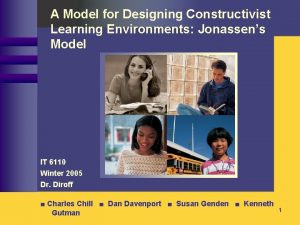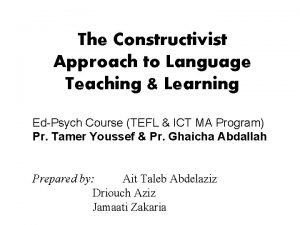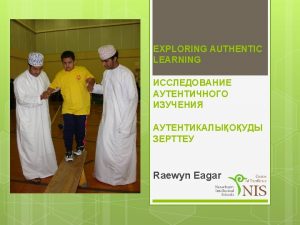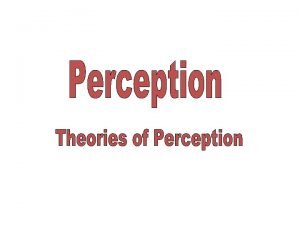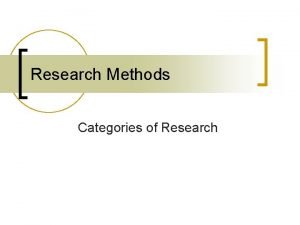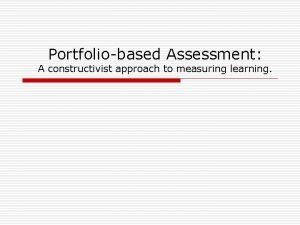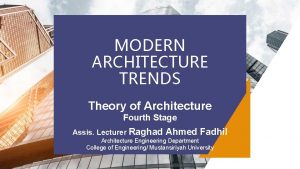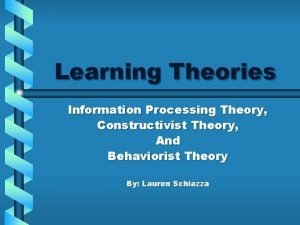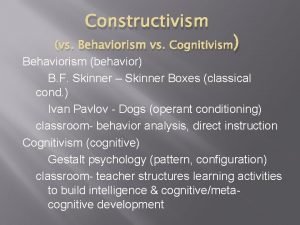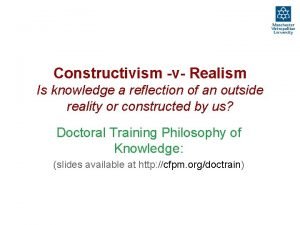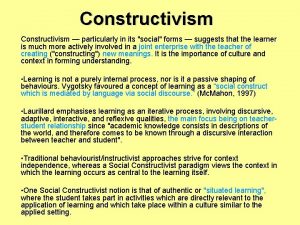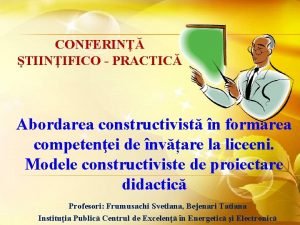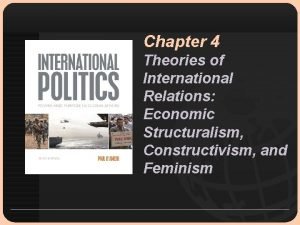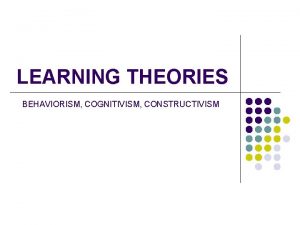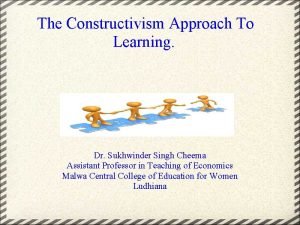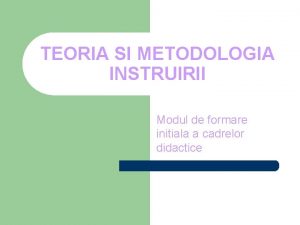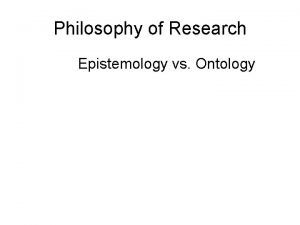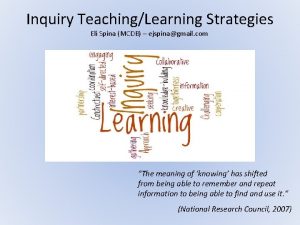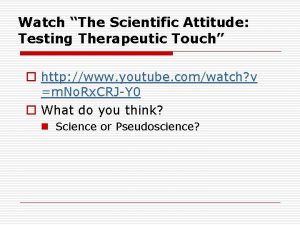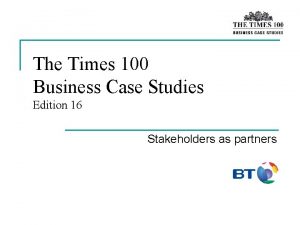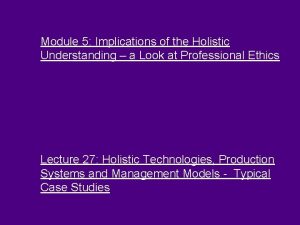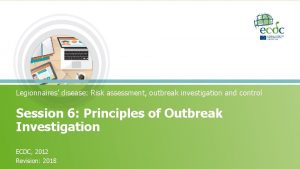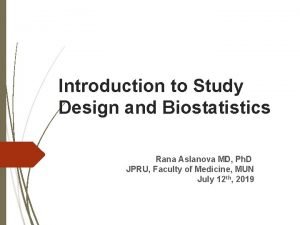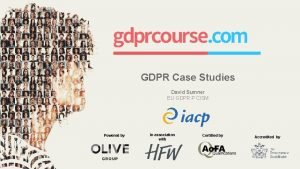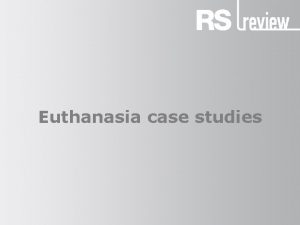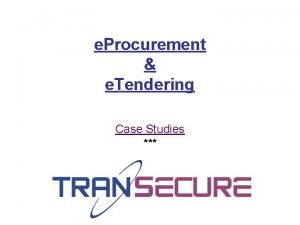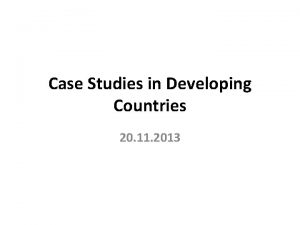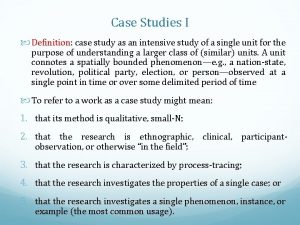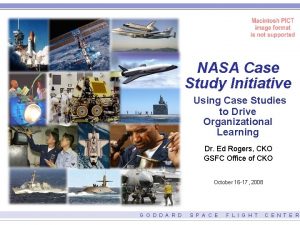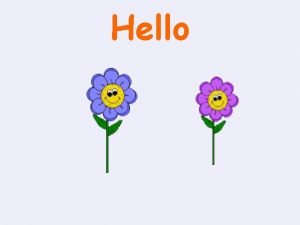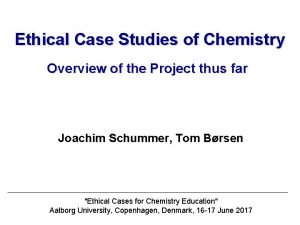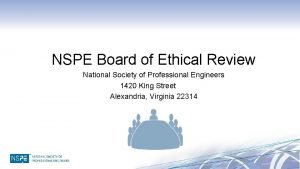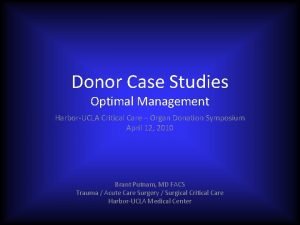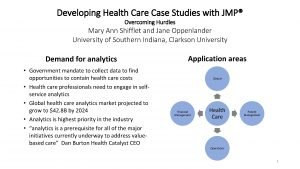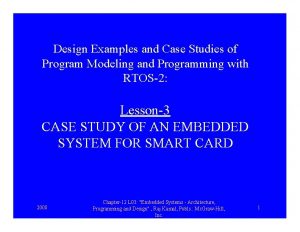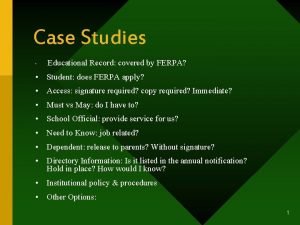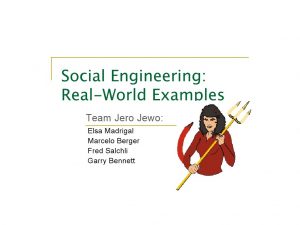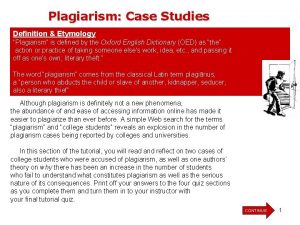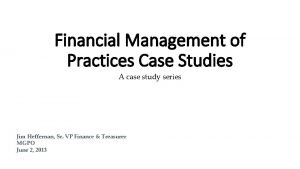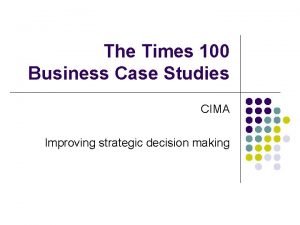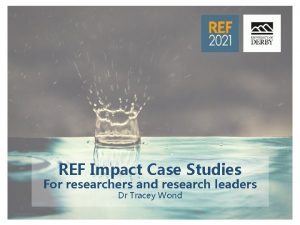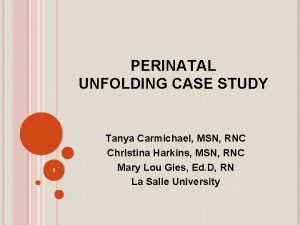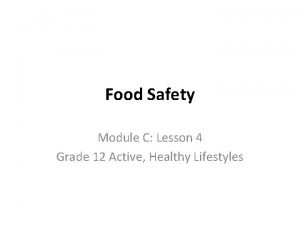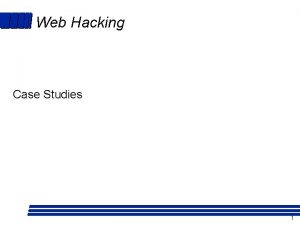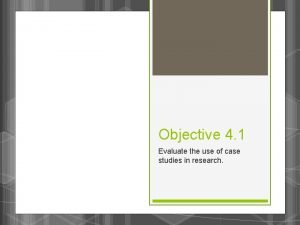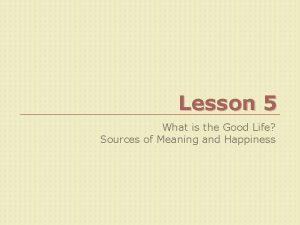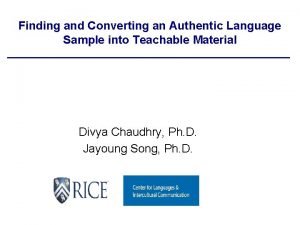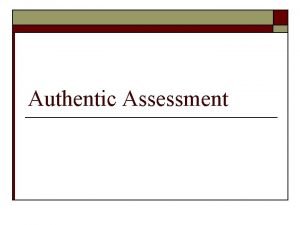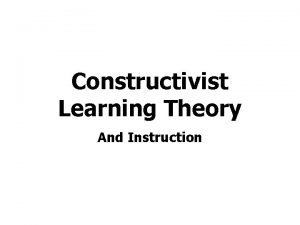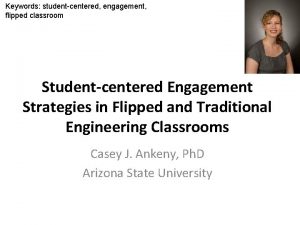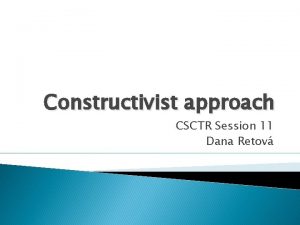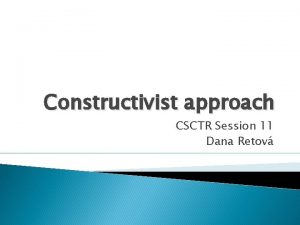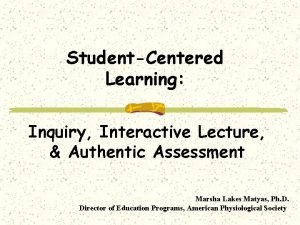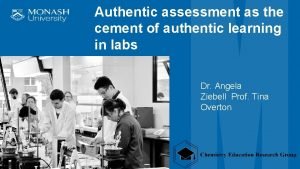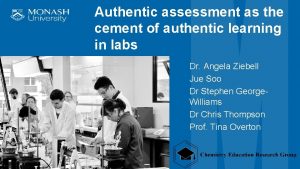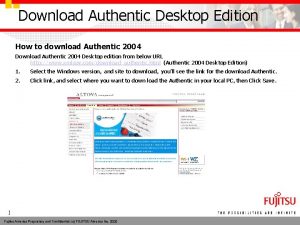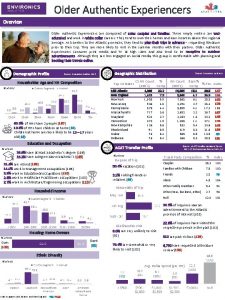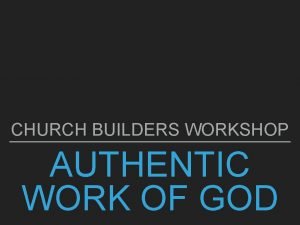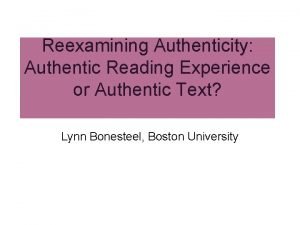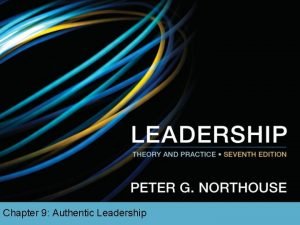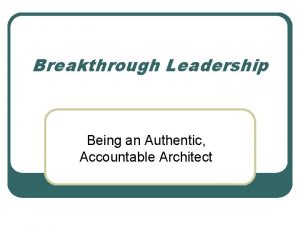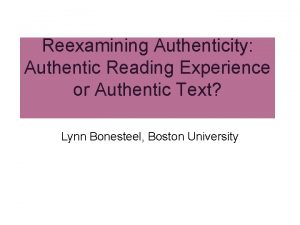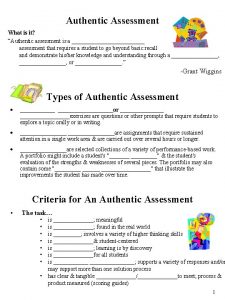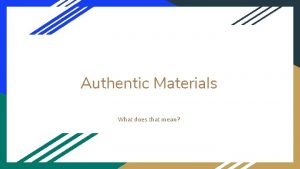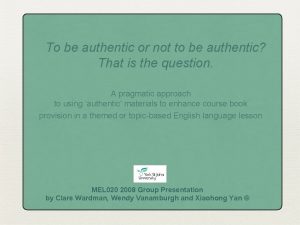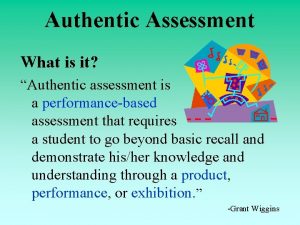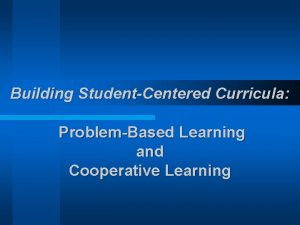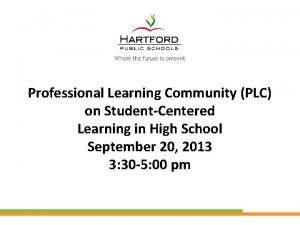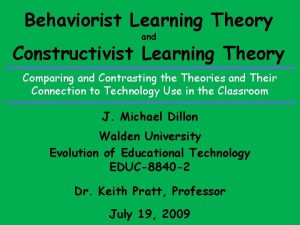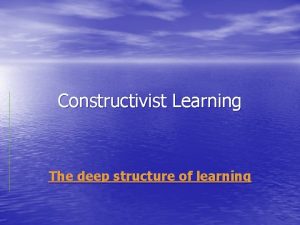Constructivist Learning Models Case studies in authentic studentcentered


























































- Slides: 58

Constructivist Learning Models: Case studies in authentic, studentcentered design

About the Presenter Marc is an instructional design consultant and certified distance learning mentor. He has a broad professional background spanning the corporate, government and academic sectors. The list of organizations Mr. Zolar has worked with on learning and development programs includes: America Online, American Research Institute, AT&T, Central Carolina Community College, Florida State University, IBM, U. S. Department of Defense, United State Marine Corps, University of North Carolina at Wilmington, Verizon, Walden University. He holds a Master’s degree in instructional design and development and is active in professional organizations in the field as a writer and speaker. Marc can be reached at mzolar@gmail. com

Why are you here today? l l What piqued your interest about this session? Have you tried incorporating constructivist learning strategies into your courses. If so, how did it go?

What is Constructivism? “Constructivism is a philosophy of learning founded on the premise that, by reflecting on our experiences, we construct our own understanding of the world we live in. Each of us generates our own "rules" and "mental models, " which we use to make sense of our experiences. Learning, therefore, is simply the process of adjusting our mental models to accommodate new experiences. “ (Source: http: //www. funderstanding. com/constructivism. cfm)

Principles of Constructivism l l Learning is a search for meaning Learning occurs in a context Instruction is tailored to learners’ mental models Constructing knowledge is purpose of learning (not “right” vs. “wrong”) (Source: Zolar, M. Constructivism 101. NC Quest Program, University of North Carolina at Wilmington. )

Impact on Curriculum l l l Less standardized curriculum Customized to connect to learner’s prior knowledge Emphasizes hands-on problem- solving (Source: Zolar, M. Constructivism 101. NC Quest Program, University of North Carolina at Wilmington. )

Impact on Instruction l l l Teacher as facilitator/guide rather than authority Focus on making connections between facts Experimentation, openended questions, extensive reflection, dialogue among students (Source: Zolar, M. Constructivism 101. NC Quest Program, University of North Carolina at Wilmington. )

Impact on Assessment l l l Ongoing assessment during instruction De-emphasizes traditional grading methods Self-assessment, learner articulates growth through projects and reflection (Source: Zolar, M. Constructivism 101. NC Quest Program, University of North Carolina at Wilmington. )

Constructivist Strategies l l l Inquiry learning Discovery learning Situational learning Problem-based learning Cognitive Apprenticeship (Source: Zolar, M. Constructivism 101. NC Quest Program, University of North Carolina at Wilmington. )

Constructivist Words and Phrases l l l l Context Authentic Multiple perspectives Learner-centered Prior knowledge Higher-order thinking Meaningful connections Social negotiation (Source: Zolar, M. Constructivism 101. NC Quest Program, University of North Carolina at Wilmington. )

Discussion Question #1 l What constructivist strategies have you used in your classroom?

Discussion Question #2 l Why is it difficult to be a constructivist in the community college environment?

Discussion Question #3 l When might constructivism be the wrong approach?

Discussion Question #4 l What makes constructivism a good approach for the community college environment?

What Does a Constructivist Course Look Like? l l (Source: Zolar, M. Constructivism 101. NC Quest Program, University of North Carolina at Wilmington. ) Multiple delivery methods High degree of student ownership and responsibility in the learning process Consistent use of reflective practice Portfolio-based assessment

Model #1: Discovery Learning l In its simplest form, discovery learning is described as the tools and information needed to solve a problem or learn a concept are provided and the learner "makes sense" of them. (Source: Dabbagh, N. Instructional Design Knowledge Base. George Mason University. )

Discovery Learning example: The Galileo Project

The Galileo Project l l l http: //galileo. rice. edu/index. html “The Galileo Project is a source of information on the life and work of Galileo Galilei (15641642). Our aim is to provide hypertextual information about Galileo and the science of his time to viewers of all ages and levels of expertise. ” Site includes suggested Lesson Plans.

The Galileo Project

The Galileo Project

The Galileo Project

The Galileo Project

The Galileo Project

Model #2: Situated Learning l Situated learning theory suggests that learning as it normally occurs is a function of the activity, context and culture in which it occurs (i. e. , it is situated). This contrasts with most classroom learning activities which involve knowledge which is abstract and out of context. Social interaction is a critical component of situated learning -- learners become involved in a "community of practice" which embodies certain beliefs and behaviors to be acquired. (Source: Dabbagh, N. Instructional Design Knowledge Base. George Mason University. )

Situated Learning example: Zero Tolerance at Layne County

Zero Tolerance at Layne County l l http: //curry. edschool. virginia. edu/go/ZT/home. html (Mable Kinzie, Margaret Grogan, Susannah Mc. Gowan) Analyzes the following State Zero Tolerance Law: “A new law requires school boards to expel students who have "brought a controlled substance, imitation controlled substance, or marijuana onto school property or to a school-sponsored activity, as prohibited by § 18. 2 -255. 2. " The school board may, in a particular case, determine that another disciplinary action is appropriate. (HB 1343, Code § 22. 1 -277. 01: 1)” l Learner is presented with Case Analysis steps and a variety of Web-based materials to form an opinion on whether the Layne County School Board has used discretion in this case.

Zero Tolerance at Layne County: Case Analysis Steps

Zero Tolerance at Layne County: Case Analysis Steps

Zero Tolerance at Layne County: Principal’s Journal

Zero Tolerance at Layne County: School Policies and Procedures

Zero Tolerance at Layne County: Community Profile

Zero Tolerance at Layne County: Expert Perspectives

Model #3: Problem-based Learning l PBL engages the learner in a problem-solving activity. In this process, instruction begins with a problem to be solved rather than content to be mastered (Hsiao, 1996). Students are introduced to a real-world problem and are encouraged to dive into it, construct their own understanding of the situation, and eventually find a solution (Grabowski, Koszalka, & Mccarth, 1998). Major goals of PBL are to help students develop collaborative learning skills, reasoning skills, and self-directed learning strategies (Hsiao, 1996). (Source: Dabbagh, N. Instructional Design Knowledge Base. George Mason University. )

5 Strategies for Using Problembased Learning l l l The Problem as a Guide - The problem is presented in order to gain attention prior to presenting the lesson. The Problem as an Integrator or Test - The problem is presented after readings are completed and/or discussed -- these are used to check for understanding. The Problem as an Example - The problem is integrated into the material in order to illustrate a particular principle, concept or procedure. The Problem as a Vehicle for Process - The problem is used to promote critical thinking whereby the analysis of how to solve it becomes a lesson in itself. The Problem as a Stimulus for Authentic Activity - The problem is used to develop skills necessary to solve it and other problems -- skills can include physical skills, recall of prior knowledge, and metacognitive skills related to the problem solving process. A form of authentic assessment of the skills and activity necessary in the content domain (Duffy & Cunningham, 1996, p. 190). (Source: Dabbagh, N. Instructional Design Knowledge Base. George Mason University. )

Problem-based Learning example: Superland!

Superland! l l http: //www 2. imsa. edu/programs/pbln/problem s/superland/ (Illinois Mathematics and Science Academy) Examines the potential risks associated with a proposal for a new theme park. Learner is placed in the role of a panel member appointed by the Governor of Illinois. Learners must produce a risk assessment report for the Governor.

Superland!: Economic Aspects and Benefits

Superland!: Learner’s task

Superland!: The Panel’s Task

Superland!: Letter of Appointment

Superland!

Model #4: Inquiry-based Learning l Inquiry-based learning is an approach to instruction that engages students in investigations to satisfy curiosities. Curiosities are satisfied when individuals construct mental frameworks that adequately explain their experiences (Haury, 1993). The learner's involvement in the learning content fosters skills and attitudes that permit the learner to seek resolutions to questions and issues while constructing new and meaningful knowledge (Inquiry-based Learning: Explanation, 2001, April). (Source: Dabbagh, N. Instructional Design Knowledge Base. George Mason University. )

Inquiry-based Learning example: American Civil War Web. Quest

American Civil War Web. Quest l l l Kimberlye Joyce and Particia Stohr-Hunt, University of Richmond at: http: //oncampus. richmond. edu/academics/ed ucation/projects/webquests/civilwar/ Learners work in groups where each member must choose a role and the follow the prescribed process Desired outcomes and evaluation criteria are clearly defined.

American Civil War Web. Quest: Introduction

American Civil War Web. Quest: Task

American Civil War Web. Quest: Process

American Civil War Web. Quest: Evaluation

Model #5: Cognitive Apprenticeship l The focus of this learning-through-guided-experience is on cognitive and metacognitive skills, rather than on the physical skills and processes of traditional apprenticeships. Applying apprenticeship methods to largely cognitive skills requires the externalization of processes that are usually carried out internally. Observing the processes by which an expert listener or reader thinks and practices these skills can teach students to learn on their own more skillfully (Collins, Brown, Newman, 1989, p. 457 -548). (Source: Dabbagh, N. Instructional Design Knowledge Base. George Mason University. )

Components of Cognitive Apprenticeship l l l Modeling - involves an expert's carrying out a task so that student can observe and build a conceptual model of the processes that are required to accomplish the task. For example, a teacher might model the reading process by reading aloud in one voice, while verbalizing her thought processes (summarize what she just read, what she thinks might happen next) in another voice. Coaching - consists of observing students while they carry out a task and offering hints, feedback, modeling, reminders, etc. Articulation - includes any method of getting students to articulate their knowledge, reasoning, or problem-solving processes. Reflection - enables students to compare their own problem-solving processes with those of an expert or another student. Exploration - involves pushing students into a mode of problem solving on their own. Forcing them to do exploration is critical, if they are to learn how to frame questions or problems that are interesting and that they can solve (Collins, Brown, Newman, 1989, 481 -482). (Source: Dabbagh, N. Instructional Design Knowledge Base. George Mason University. )

Cognitive Apprenticeship example: Fair Lending Challenge (Developed by Interworks. All Rights Reserved. ) The goal of this multimedia course is to teach fair lending practices to bank loan officers and to reinforce the need to make loans that are secure and profitable. In the course, learners are presented with a series of loan applicants on a laptop computer on their desks. When an applicant is selected, an interview is conducted where information that is present on the loan application and credit reports can be clarified. • Reference guide provides neighborhood advantage guidelines and other information needed in determining the loan. • Learner indicates whether the loan should be approved or disapproved, and explains the reasons for the decision. Source: http: //www. macromedia. com/support/authorware/basics/instruct 18. html

Cognitive Apprenticeship example: Fair Lending Challenge (Developed by Interworks. All Rights Reserved. ) Following the interview: • Bank lawyer provides immediate feedback if fair lending practices have been violated by the types of questions asked. • Branch manager gives the learners a performance appraisal. A week at work is compressed into two hours of game time, thereby allowing much experience to be rapidly gained. Source: http: //www. macromedia. com/support/authorware/basics/instruct 18. html

Cognitive Apprenticeship example: Creating an Effective Foreign Language Classroom Lesson plan for 1 st year language class in high school or middle school, or as an introduction to the unit for any language level. Objectives: Students will learn verbs for playing golf through help from their teacher in a cognitive apprenticeship approach. Goals: Students will learn how to conjugate regular verbs and they will then apply the rule that they learn to conjugating verbs fluidly in their own skits in the target language. Materials: Golf equipment Source: http: //www. wcer. wisc. edu/step/ep 301/Fall 2000/Tochonites/cogaplesson. html

Cognitive Apprenticeship example: Creating an Effective Foreign Language Classroom Activities: 1. The teacher gives a mini-dialogue about golf, using different conjugations of regular verbs in context. 2. The students and the teacher work together to analyze verb use in the story to create a rule that works for conjugating regular verbs. 3. The class works together to create a new dialogue using properly conjugated regular verbs. 4. Students work in pairs to use the information they learned about verbs to create their own skit that they perform for the class. Source: http: //www. wcer. wisc. edu/step/ep 301/Fall 2000/Tochonites/cogaplesson. html

Cognitive Apprenticeship example: Creating an Effective Foreign Language Classroom Assessment: The students will be given feedback throughout the lesson about how they are using the verbs. Their final assessment will be the skit -- whether or not they conjugated the verbs correctly. Why this lesson is student centered: The topic of the lesson has been chosen by the students (golf). Also, since the teacher facilitates the whole lesson and gives up control more and more to the students, they are taking more and more of the lead of the classroom. The lesson moves at their pace; they get more responsibility only when they are ready for it. Eventually, they take the lead as they develop their own skits to show to the class. Source: http: //www. wcer. wisc. edu/step/ep 301/Fall 2000/Tochonites/cogaplesson. html

Resources Multimedia Cases (Situated Learning): http: //kinzie. edschool. virginia. edu/id. html Mable Kinzie, University of Virginia Concept to Classroom at: http: //www. thirteen. org/edonline/concept 2 class/index. html Instructional Design Knowledge Base at George Mason University at: http: //classweb. gmu. edu/ndabbagh/Resources/IDKB/index. htm Center for Teaching and Learning Website at Georgia State University. Available at: http: //www 2. gsu. edu/~wwwctl/ The Galileo Project, Rice University at: http: //galileo. rice. edu/index. html Superland! at: http: //www 2. imsa. edu/programs/pbln/problems/superland/ (Illinois Mathematics and Science Academy) University of Richmond Web. Quests at: http: //oncampus. richmond. edu/academics/education/projects/webquests Explorations in Learning and Instruction: Theory Into Practice (TIP) Database at: http: //tip. psychology. org/ Learning and Teaching Website, James Atherton at: http: //www. learningandteaching. info/ Facilitation: A Different Pedagogy? ; CDTLink at: http: //www. cdtl. nus. edu. sg/link/Mar 2002/tm 4. htm Pedicases at: http: //www. pedicases. org/home. phtml

Resources, continued. UMUC-Verizon Virtual Resource Site for Teaching with Technology: http: //www. umuc. edu/virtualteaching/vt_home. html Web Teacher at: http: //www. webteacher. org/windows. html Moodle (freeware course management system) at: http: //moodle. com/? moodlead=moodle. org Big Dog’s ISD page at: http: //www. nwlink. com/~donclark/hrd/sat. html#intro Yahoo Web Beginner’s Guides at: http: //dir. yahoo. com/Computers_and_Internet/World_Wide_Web/Beginner_s_Guides Distance Education Clearinghouse at: http: //www. uwex. edu/disted/home. html Interworks Fair Lending Challenge at: http: //www. interw. com/FLC. html University of Hawaii, Faculty Development Teaching Tips Index at: http: //honolulu. hawaii. edu/intranet/committees/Fac. Dev. Com/guidebk/teachtip. htm#assessment Problem-based Learning, Samford University at: http: //home. capecod. net/~tpanitz/pbl. htm IMSA Problem-based Learning Network at: http: //www 2. imsa. edu/programs/pbln/problems/ Project, Problem and Inquiry-based learning at: http: //eduscapes. com/tap/topic 43. htm

References Baenen, J. , Drury, J. , Mc. Guire, S. , Muzenski, H. , Stampen, J. , Storch, S. Creating an Effective Foreign Language Classroom at: http: //www. wcer. wisc. edu/step/ep 301/Fall 2000/Tochonites/cogaplesson. html Retrieved April 4, 2006. Dabbagh, N. (Feb 26, 2006). The Instructional Design Knowledge Base. Retrieved February 26, 2006 from Nada Dabbagh's Homepage, George Mason University, Instructional Technology Program. Website: http: //classweb. gmu. edu/ndabbagh/Resources/IDKB/index. htm Illoinis Mathematics and Science Academy, Superland! at: http: //www 2. imsa. edu/programs/pbln/problems/superland/ Interworks, Fair Lending Challenge. Macromedia Support Center at: http: //www. macromedia. com/support/authorware/basics/instruct 18. html Joyce, Kimberly. Stohr-Hunt, Patricia. American Civil War Webquest. University of Richmond at: http: //oncampus. richmond. edu/academics/education/projects/webquests/civilwar/ Kinzie, Mabel; Grogan, Margaret, Mc. Gowan, Susannah. Zero Tolerance at Layne County at: http: //curry. edschool. virginia. edu/go/ZT/home. html Macromedia Authorware Support Center, The promise of cognitive apprenticeship at: http: //www. macromedia. com/support/authorware/basics/instruct 18. html NC Quest Program, University of North Carolina at Wilmington at: http: //www. uncw. edu/ed/ncquest/ Van Helden, Albert, The Galileo Project, Rice University at: http: //galileo. rice. edu/index. html Zolar, M. (2004) Constructivism 101. NC Quest Program, University of North Carolina at Wilmington. )
 Jonassen constructivism
Jonassen constructivism Social constructivist meaning
Social constructivist meaning Authentic learning
Authentic learning Best case worst case average case
Best case worst case average case Gregory top down theory of perception
Gregory top down theory of perception Research objectives sample
Research objectives sample Constructivist assessment examples
Constructivist assessment examples Constructivism architecture characteristics
Constructivism architecture characteristics Information processing theory
Information processing theory Attribution theory in communication
Attribution theory in communication Cognitivism vs constructivism
Cognitivism vs constructivism Constructivist vs realist
Constructivist vs realist Social constructivist meaning
Social constructivist meaning Profesorul constructivist
Profesorul constructivist Structuralism economics
Structuralism economics Constructivism vs behaviorism vs cognitivism
Constructivism vs behaviorism vs cognitivism Kathy charmaz
Kathy charmaz What is constructivism
What is constructivism Modelul constructivist al invatarii
Modelul constructivist al invatarii Epistemology vs ontology
Epistemology vs ontology Constructivist etymology
Constructivist etymology Paradigm shift from women studies to gender studies
Paradigm shift from women studies to gender studies What is the difference between models and semi modals
What is the difference between models and semi modals Cuadro comparativo entre e-learning b-learning y m-learning
Cuadro comparativo entre e-learning b-learning y m-learning Advantages of descriptive research
Advantages of descriptive research Times 100 business case studies
Times 100 business case studies Times 100 business case studies
Times 100 business case studies Case studies of typical holistic technologies
Case studies of typical holistic technologies Example of outbreak
Example of outbreak Case series
Case series Eu-gdpr-p
Eu-gdpr-p Gcse geography case studies
Gcse geography case studies Tony bland euthanasia
Tony bland euthanasia E procurement case studies
E procurement case studies Types of case studies
Types of case studies Define: case study
Define: case study The times 100 business case studies
The times 100 business case studies Nasa case study
Nasa case study Abo antisera
Abo antisera Chemistry-ethics case studies
Chemistry-ethics case studies Nspe case studies
Nspe case studies Organ donation case studies
Organ donation case studies Jmp case studies
Jmp case studies Case studies of rtos
Case studies of rtos Ferpa case studies
Ferpa case studies Social engineering case studies
Social engineering case studies Etymology of plagiarism
Etymology of plagiarism Case studies financial management
Case studies financial management Digital marketing case studies 2012
Digital marketing case studies 2012 Blowfly girl deer pictures
Blowfly girl deer pictures The times 100 business case studies
The times 100 business case studies Ref impact case studies
Ref impact case studies Qsen unfolding case studies
Qsen unfolding case studies Food safety errors: case studies
Food safety errors: case studies Growth hacking case studies
Growth hacking case studies Exercise #1 – evaluate case studies answer key
Exercise #1 – evaluate case studies answer key Golden rule
Golden rule Record of conversation example
Record of conversation example Traditional and authentic assessment similarities
Traditional and authentic assessment similarities
